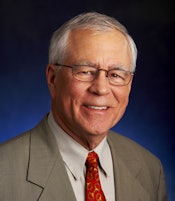
AuntMinnie.com is pleased to present the next installment of Leaders in Imaging, a series of interviews with individuals who are shaping the radiology landscape. We spoke with William Hendee, PhD, professor of radiology, radiation oncology, biophysics, and community and public health at the Medical College of Wisconsin in Milwaukee.
Hendee has also served as vice president for science and technology at the American Medical Association (AMA) and as executive secretary of the AMA Council on Science and Public Health. Most recently, he was lead author of a paper titled "Addressing Overutilization in Medical Imaging," published online in August in Radiology.
AuntMinnie: Why do you think medical imaging is overused?
 |
| William Hendee, PhD, from the Medical College of Wisconsin in Milwaukee. |
Where does the self-referral situation stand now? What affect has the Stark law had on this practice?
The Stark law is only applicable to certain situations -- it doesn't cover the whole waterfront. Physicians who self-refer argue that they're making care more convenient for the patient, and that patient convenience counters the financial interest issue. Perhaps, but certainly one can say that because of financial interest [the practice of] physician self-referral can be based on the wrong motives.
What are the pitfalls of a legislative approach to curbing self-referral? Is it better for the radiology community to participate in these efforts or flat-out oppose them?
It's better for the physician community to deal with this problem itself rather than relying on regulatory action. Don't get me wrong -- I'd like to see tort reform at a congressional level that would protect physicians from wanton and unnecessary lawsuits. But unfortunately, I don't see that happening any time soon. There's more and more awareness within the medical field that the cost of care is not sustainable and that physicians have an ethical and professional responsibility to deal with this.
You recommend educating referring physicians as one of the most effective ways to reduce inappropriate imaging. What's the best way to accomplish this, in concrete terms? What can radiologists do?
Radiologists can speak at meetings of medical professional societies, especially about the high-cost and high-dose issues. It would be very helpful if radiologists made overtures to other medical societies.
About two or three years ago, the Image Gently campaign started, to support radiologists to choose the best exams for pediatric patients at the lowest doses possible to get relevant clinical information. That's been a fantastic success -- it's been widely adopted by pediatric radiology and by children's hospitals across the country.
Now the American College of Radiology, along with the Radiological Society of North America, the American Registry of Radiologic Technologists, and the American Association of Physicists in Medicine, is developing a second campaign called Image Wisely that will apply to all procedures. We'll be rolling the campaign out at this year's RSNA meeting, with an initial focus on CT.
Are there any benefits to the "defensive medicine" culture? Can this medical practice be changed?
I don't know of any benefits to defensive medicine. If you're taking studies to protect yourself rather than in the best interest of the patient, that's an improper reason. Of course, we can certainly understand a physician trying to cover his liability, especially with the current legal climate in this country. I don't see any way around [the practice of defensive medicine] short of tort reform, which would provide protection for physicians using their best judgment. There's been an effort to get tort reform introduced in Congress, but that effort has been unremittingly unsuccessful, and malpractice laws are now one of the major contributors to uncontrolled cost of healthcare.
I think there is a promising approach to this entire issue of overuse, however: decision-support systems that are accessible at the time the referring physician requests the study. Decision-support systems give physicians immediate information about whether the study is the preferred one for the patient and, if not, guidance as to what might be preferable. It also can generate "report cards" for physicians, so they can track how their ordering behavior compares to their colleagues in the facility. Decision-support software would help counter overutilization, and I think there will be increasing interest from vendors in developing these to go along with computerized order entry.
What role does appropriateness criteria play in the overall practice of healthcare?
The American College of Radiology has several hundred appropriateness criteria, but referring physicians often don't know about them. These criteria have to be more accessible, perhaps by migrating them off the website and into a facility's [clinical order-entry system].
Another issue is that most appropriateness criteria are consensus-based -- developed by a group of radiologists who work on a specific area -- rather than evidence-based. The challenge for radiology is to move from consensus to solid evidence on what works and doesn't work. Yes, it's hard to generate evidence that shows a particular imaging procedure is better than another for a patient. But we have to move in that direction, even if we use surrogate measures of evidence.
What do you wish medical students could be taught that would change the way medicine is practiced now?
Medical students have got to learn that cost-effectiveness is an important part of the delivery of care. It has to be one of the criteria that they're taught and evaluated on: how to make decisions that combine the best care for patients but are also cost-effective.
For that matter, radiologists need to become part of the referring physician's decision-making process. I don't see them in a gatekeeper role -- except for some high-cost, high-dose studies, like CT angiography or PET scans -- but they do need to put decision-support systems in place.
What's your perspective on radiology benefits management (RBM) firms, and preauthorization as an imaging management technique?
We need to move away from that. It impedes the delivery of care. If there are the right kinds of decision-support systems, and they're being used by referring physicians, there will be no need for RBMs. Some payors have already waived preauthorization requirements for institutions that are using decision-support systems.
In your article in August in Radiology, you noted that "as many as 20% to 50% of high-tech imaging procedures fail to provide information that improves patient welfare." Do you believe that figure is accurate? Why or why not?
We pulled [that range] out of the literature, but we don't know what the exact number is simply because it's hard to track. After the fact, you can look at imaging processes, determine, OK, this was negative, it didn't contribute to the patient's care, or the decision about the patient was made before image was even interpreted. But you can't really tell what an imaging study will show until you do it.
Do you feel the American Board of Radiology Foundation's August 2009 meeting on overutilization has yielded productive results? Why or why not?
I think it was a good meeting. We had a lot of physicians from other medical organizations who participated as well. The message out of that meeting and the recent one this year is that an underlying problem is the lack of effective communication between referring physicians and radiologists. How can we do a better job of communicating, between radiologists and referring doctors, radiologists themselves, and radiologists and patients? We're now trying to decide where to go from here.
In your Radiology paper, you wrote that one of two ways to curb physician self-referral is through the actions of the physician community. Do you think it's realistic to expect that physicians will police themselves when so many are making money on this practice?
I think there are a lot of well-meaning physicians out there who recognize that self-referral often contains inappropriate financial incentives, and I'd like to think that they'll address the problem as the cost of healthcare keeps increasing, and it becomes more and more clear that it's not sustainable. I would hope that different medical groups would take more active roles, as well.
In fact, the topic of ethics in professionalism is gaining interest. What does it mean to operate professionally? Well, it means you make a decision that's in the best interest of the patient, not according to some prevailing norm. I think there's a growing movement to encourage physicians to think in the most professional and ethical manner possible.
By Kate Madden Yee
AuntMinnie.com staff writer
October 13, 2010
Related Reading
Leaders in Imaging: David Dowe, MD, September 15, 2010
Radiologists call for curbs on overuse of imaging, August 24, 2010
CMS unveils imaging decision-support initiative, July 23, 2010
Leaders in Imaging: Cynthia Sherry, MD, July 8, 2010
Leaders in Imaging: Dr. Leonard Berlin, May 25, 2010
Copyright © 2010 AuntMinnie.com




















